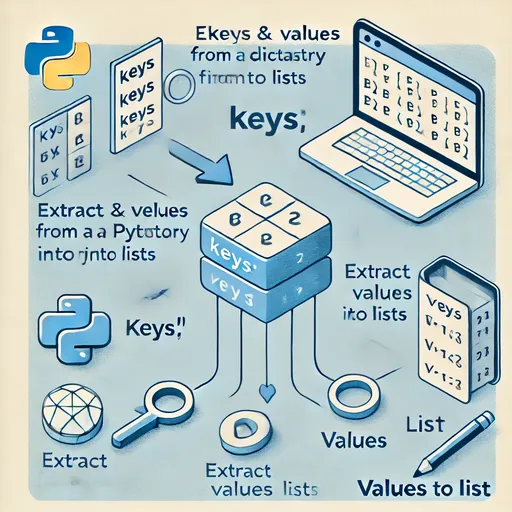A Python Dictionary is a data structure composed of keys and values, and it's used in various data processing tasks. In this post, we will introduce various methods to extract keys and values from a Dictionary separately and convert them into lists.
1. Extracting Only Keys from a Dictionary
To extract keys from a Dictionary, use the keys() method. This method returns all keys of the Dictionary, and you can wrap it with list() to convert it into a list.
Example 1: Using the keys() Method
my_dict = {'name': 'Alice', 'age': 25, 'city': 'Seoul'}
# Extracting keys into a list
keys_list = list(my_dict.keys())
print(keys_list) # Output: ['name', 'age', 'city']Example 2: Using List Comprehension
You can also extract keys into a list using the keys() method along with a for loop.
keys_list = [key for key in my_dict]
print(keys_list) # Output: ['name', 'age', 'city']2. Extracting Only Values from a Dictionary
To extract values from a Dictionary, use the values() method. This method returns all values of the Dictionary, and you can similarly convert it using list().
Example 1: Using the values() Method
my_dict = {'name': 'Alice', 'age': 25, 'city': 'Seoul'}
# Extracting values into a list
values_list = list(my_dict.values())
print(values_list) # Output: ['Alice', 25, 'Seoul']Example 2: Using List Comprehension
You can also extract values from the Dictionary into a list using a for loop.
values_list = [value for value in my_dict.values()]
print(values_list) # Output: ['Alice', 25, 'Seoul']3. Extracting Keys and Values Simultaneously
If you want to extract keys and values into their respective lists at the same time, you can use the following methods.
Example: Using keys() and values() Together
my_dict = {'name': 'Alice', 'age': 25, 'city': 'Seoul'}
# Extracting keys and values into lists simultaneously
keys_list = list(my_dict.keys())
values_list = list(my_dict.values())
print(keys_list) # Output: ['name', 'age', 'city']
print(values_list) # Output: ['Alice', 25, 'Seoul']Example: Using items() and Unpacking
my_dict = {'name': 'Alice', 'age': 25, 'city': 'Seoul'}
keys_list = [key for key, _ in my_dict.items()]
values_list = [value for _, value in my_dict.items()]
print(keys_list) # Output: ['name', 'age', 'city']
print(values_list) # Output: ['Alice', 25, 'Seoul']
4. Creating a List of Combined Keys and Values
If you want to store keys and values from a Dictionary as pairs in a list, you can use the items() method.
Example: Creating a List of Key-Value Pairs
my_dict = {'name': 'Alice', 'age': 25, 'city': 'Seoul'}
# Extracting key-value pairs into a list
pairs_list = list(my_dict.items())
print(pairs_list) # Output: [('name', 'Alice'), ('age', 25), ('city', 'Seoul')]5. Application: Creating a Sorted List of Keys or Values
If you want to create sorted lists of keys and values, you can use sorted().
Example 1: Sorting Keys into a List
my_dict = {'b': 2, 'a': 1, 'c': 3}
sorted_keys = sorted(my_dict.keys())
print(sorted_keys) # Output: ['a', 'b', 'c']Example 2: Sorting Values into a List
sorted_values = sorted(my_dict.values())
print(sorted_values) # Output: [1, 2, 3]6. Summary
| Operation | Method | Example Code |
|---|---|---|
| Extract only keys into a list | list(my_dict.keys()) |
keys_list = list(my_dict.keys()) |
| Extract only values into a list | list(my_dict.values()) |
values_list = list(my_dict.values()) |
| Extract key-value pairs into a list | list(my_dict.items()) |
pairs_list = list(my_dict.items()) |
| Create a sorted list of keys | sorted(my_dict.keys()) |
sorted_keys = sorted(my_dict.keys()) |
| Create a sorted list of values | sorted(my_dict.values()) |
sorted_values = sorted(my_dict.values()) |
Utilize the various methods to extract keys and values from a Python Dictionary into lists for more efficient data processing tasks! 😊

There are no comments.